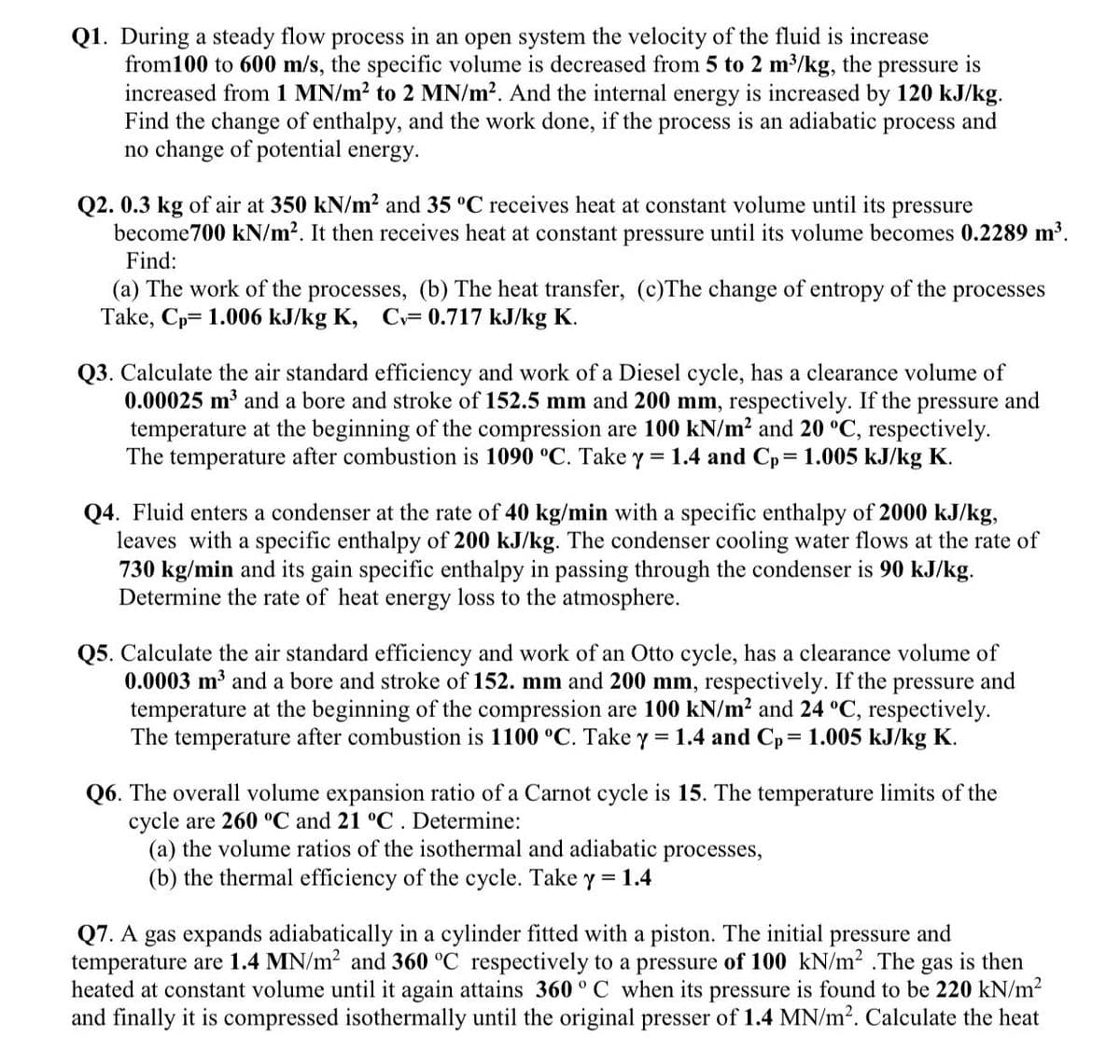Q1. During a steady flow process in an open system the velocity of the fluid is increase from100 to 600 m/s, the specific volume is decreased from 5 to 2 m³/kg, the pressure is increased from 1 MN/m? to 2 MN/m?. And the internal energy is increased by 120 kJ/kg. Find the change of enthalpy, and the work done, if the process is an adiabatic process and no change of potential energy.
Q1. During a steady flow process in an open system the velocity of the fluid is increase from100 to 600 m/s, the specific volume is decreased from 5 to 2 m³/kg, the pressure is increased from 1 MN/m? to 2 MN/m?. And the internal energy is increased by 120 kJ/kg. Find the change of enthalpy, and the work done, if the process is an adiabatic process and no change of potential energy.
Physical Chemistry
2nd Edition
ISBN:9781133958437
Author:Ball, David W. (david Warren), BAER, Tomas
Publisher:Ball, David W. (david Warren), BAER, Tomas
Chapter2: The First Law Of Thermodynamics
Section: Chapter Questions
Problem 2.32E: Many compressed gases come in large,heavy metal cylindersthat are so heavy that they need a special...
Related questions
Question
i need the answer quickly

Transcribed Image Text:Q1. During a steady flow process in an open system the velocity of the fluid is increase
from100 to 600 m/s, the specific volume is decreased from 5 to 2 m³/kg, the pressure is
increased from 1 MN/m? to 2 MN/m2. And the internal energy is increased by 120 kJ/kg.
Find the change of enthalpy, and the work done, if the process is an adiabatic process and
no change of potential energy.
Q2. 0.3 kg of air at 350 kN/m2 and 35 °C receives heat at constant volume until its pressure
become700 kN/m2. It then receives heat at constant pressure until its volume becomes 0.2289 m³.
Find:
(a) The work of the processes, (b) The heat transfer, (c)The change of entropy of the processes
Take, Cp= 1.006 kJ/kg K, C= 0.717 kJ/kg K.
Q3. Calculate the air standard efficiency and work of a Diesel cycle, has a clearance volume of
0.00025 m3 and a bore and stroke of 152.5 mm and 200 mm, respectively. If the pressure and
temperature at the beginning of the compression are 100 kN/m? and 20 °C, respectively.
The temperature after combustion is 1090 °C. Take y = 1.4 and Cp 1.005 kJ/kg K.
Q4. Fluid enters a condenser at the rate of 40 kg/min with a specific enthalpy of 2000 kJ/kg,
leaves with a specific enthalpy of 200 kJ/kg. The condenser cooling water flows at the rate of
730 kg/min and its gain specific enthalpy in passing through the condenser is 90 kJ/kg.
Determine the rate of heat energy loss to the atmosphere.
Q5. Calculate the air standard efficiency and work of an Otto cycle, has a clearance volume of
0.0003 m3 and a bore and stroke of 152. mm and 200 mm, respectively. If the pressure and
temperature at the beginning of the compression are 100 kN/m? and 24 °C, respectively.
The temperature after combustion is 1100 °C. Take y = 1.4 and Cp= 1.005 kJ/kg K.
Q6. The overall volume expansion ratio of a Carnot cycle is 15. The temperature limits of the
cycle are 260 °C and 21 °C. Determine:
(a) the volume ratios of the isothermal and adiabatic processes,
(b) the thermal efficiency of the cycle. Take y = 1.4
Q7. A gas expands adiabatically in a cylinder fitted with a piston. The initial pressure and
temperature are 1.4 MN/m2 and 360 °C respectively to a pressure of 100 kN/m2 .The gas is then
heated at constant volume until it again attains 360 ° C when its pressure is found to be 220 kN/m2
and finally it is compressed isothermally until the original presser of 1.4 MN/m2. Calculate the heat
Expert Solution
This question has been solved!
Explore an expertly crafted, step-by-step solution for a thorough understanding of key concepts.
Step by step
Solved in 2 steps with 2 images

Knowledge Booster
Learn more about
Need a deep-dive on the concept behind this application? Look no further. Learn more about this topic, chemistry and related others by exploring similar questions and additional content below.Recommended textbooks for you

Physical Chemistry
Chemistry
ISBN:
9781133958437
Author:
Ball, David W. (david Warren), BAER, Tomas
Publisher:
Wadsworth Cengage Learning,

Physical Chemistry
Chemistry
ISBN:
9781133958437
Author:
Ball, David W. (david Warren), BAER, Tomas
Publisher:
Wadsworth Cengage Learning,